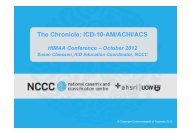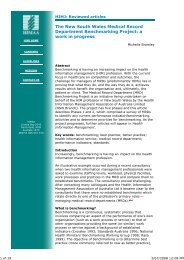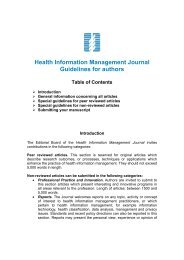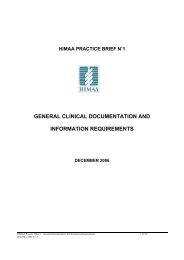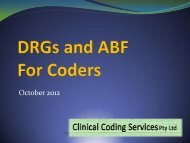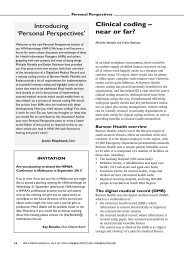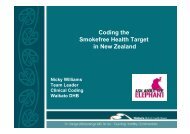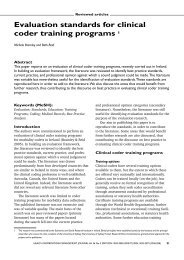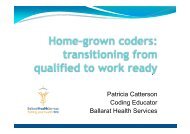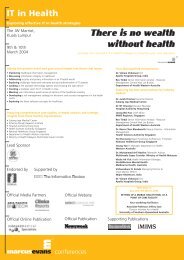A framework for evaluating health classifications - Health Information ...
A framework for evaluating health classifications - Health Information ...
A framework for evaluating health classifications - Health Information ...
Create successful ePaper yourself
Turn your PDF publications into a flip-book with our unique Google optimized e-Paper software.
Reviewed Articles<br />
The Systematized Nomenclature of Medicine — Clinical<br />
Terms (SNOMED-CT) (College of American Pathologists<br />
n.d.) is a concept-oriented reference terminology. In<br />
SNOMED-CT, concepts and terms and their relationship to<br />
each other are the primary focus. Users rarely see the<br />
codes; they are simply a management tool to enable computerised<br />
identification and retrieval. In this example, the<br />
concept identifiers (Conceptid) are the codes; they are<br />
randomly assigned to concepts and convey no meaning.<br />
• Influenza (Conceptid 6142004)<br />
• Influenzal pneumonia (Conceptid 39932903)<br />
• Influenzal laryngitis (Conceptid 19463902)<br />
• Influenzal pharyngitis (Conceptid 19452905)<br />
(Source: Scott 2004)<br />
Meaningful coding systems arose out of necessity<br />
to keep the hierarchical structure and <strong>for</strong>mat simple<br />
<strong>for</strong> users in a predominantly manual environment<br />
(Roberts et al. 2004). In the evaluation <strong>framework</strong>,<br />
some examples demonstrate the tensions that exist in<br />
maintaining a classification’s structure and its clinical<br />
relevance. An electronic environment may offer solutions<br />
to some of the problems that arise with meaningful<br />
coding systems (Roberts & Chalmers 2002).<br />
Evaluation <strong>framework</strong><br />
<strong>Health</strong> <strong>classifications</strong> can be evaluated by the characteristics<br />
that define a ‘good’ classification (Hoffman &<br />
Chamie 1999). These taxonomic principles are explained<br />
below and are themselves grouped into administrative,<br />
structural, content and usability<br />
principles.<br />
1. Administrative principles<br />
1.1 Purpose and scope (coverage)<br />
A <strong>health</strong> classification must have its objectives, purpose<br />
and scope (or coverage) clearly stated so that its<br />
relevance to the domain it serves, or to other domains,<br />
can be measured (Hoffman & Chamie 1999).<br />
Example 1.1a<br />
A classification of chiropractic interventions may not be<br />
suitable <strong>for</strong> use by physiotherapists who specialise in<br />
manual therapy (manipulation and mobilisation). There<br />
may be some common interventions, but generally,<br />
physiotherapy interventions are different from chiropractic<br />
interventions, because of theoretical and philosophical differences<br />
between the two disciplines (Canadian Physiotherapy<br />
Association 1994).<br />
Example 1.1b<br />
Procedure <strong>classifications</strong> generally have a broad scope because<br />
they need to encompass all types of procedures<br />
per<strong>for</strong>med in <strong>health</strong>care: diagnostic, therapeutic and preventive<br />
interventions; and invasive, non-invasive and<br />
cognitive interventions. They also need to be applicable<br />
to all clinicians, across all <strong>health</strong>care settings (Innes et al.<br />
1997; National Committee on Vital and <strong>Health</strong> Statistics<br />
Subcommittee on Medical Classification Systems 1993).<br />
1.2 Custodianship<br />
The custodian is the organisation or body responsible<br />
<strong>for</strong> the development and maintenance of a <strong>health</strong><br />
classification. They should be readily identified and<br />
their responsibilities clearly outlined (Hoffman &<br />
Chamie 1999).<br />
1.3 Maintenance/updating<br />
1.3.1 Maintenance plans<br />
<strong>Health</strong> <strong>classifications</strong> must remain credible and relevant<br />
to users and so must be maintained and updated<br />
over time. The custodian must have a plan <strong>for</strong> regular<br />
updating and maintenance (Hoffman & Chamie<br />
1999; Price 1982), which clearly documents the criteria<br />
against which a submission <strong>for</strong> change can be<br />
made. The plan should be well publicised and allow<br />
<strong>for</strong> all users and producers of statistical data to contribute<br />
to the process within an appropriate time<br />
frame (Hoffman & Chamie 1999).<br />
Example 1.3.1<br />
The NCCH updates the ICD-10-AM every 2 years. There<br />
is a public submission process advertised on its website<br />
which<br />
allows all stakeholders to participate in the update process.<br />
Similarly, the Australian Government Department<br />
of <strong>Health</strong> and Ageing updates the Australian Refined Diagnosis<br />
Related Groups (AR-DRGs) classification in line<br />
with updates to the ICD-10-AM and has a public submission<br />
process .<br />
The ICD has a ten year update cycle, though it is now<br />
more than 10 years since ICD-10 was introduced<br />
(1992). Plans to introduce ICD-11 have been extended<br />
to 2011 (Ustun 2004), primarily because the World<br />
<strong>Health</strong> Organization now has a mechanism through<br />
which the ICD is regularly updated — the WHO Update<br />
Reference Committee (National Centre <strong>for</strong> Classification<br />
in <strong>Health</strong> 2005).<br />
Because stability is crucial to statistical analysis,<br />
the impact of any updates needs to be considered<br />
by all stakeholders (Hoffman & Chamie 1999). In<br />
Australia, there are diverging views on what constitutes<br />
‘regular’ updating. Clinical coders, and the<br />
bodies responsible <strong>for</strong> maintaining <strong>classifications</strong>,<br />
prefer updates once a year or biennially so that the<br />
classification remains current, particularly in relation<br />
to surgical procedures. Researchers, policy<br />
analysts and those who maintain <strong>health</strong> in<strong>for</strong>mation<br />
systems prefer a more stable classification with less<br />
frequent updates and suggest a timeframe of 3 to 5<br />
years.<br />
1.3.2 Concept permanence<br />
Classification follows clinical research and discovery.<br />
As more is learnt about the nature of diseases and the<br />
efficacy of interventions, the better able we are to<br />
describe, define (or redefine), and classify them appropriately.<br />
Thus, the classification of clinical concepts<br />
can change over time.<br />
<strong>Health</strong> In<strong>for</strong>mation Management 2005 ISSN 1322-4913 Vol 34 No 3 Page 73




